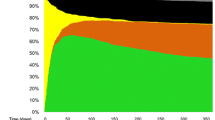Abstract
Purpose
Patients with hematologic malignancy (HM) commonly develop critical illness. Their long-term survival and functional outcomes have not been well described.
Methods
We conducted a prospective, observational study of HM patients admitted to seven Canadian intensive care units (ICUs) (2018–2020). We followed survivors at 7 days, 6 months and 12 months following ICU discharge. The primary outcome was 12-month survival. We evaluated functional outcomes at 6 and 12 months using the functional independent measure (FIM) and short form (SF)-36 as well as variables associated with 12-month survival.
Results
We enrolled 414 patients including 35% women. The median age was 61 (interquartile range, IQR: 52–69), median Sequential Organ Failure Assessment (SOFA) score was 9 (IQR: 6–12), and 22% had moderate–severe frailty (clinical frailty scale [CFS] ≥ 6). 51% had acute leukemia, 38% lymphoma/multiple myeloma, and 40% had received a hematopoietic stem cell transplant (HCT). The most common reasons for ICU admission were acute respiratory failure (50%) and sepsis (40%). Overall, 203 (49%) were alive 7 days post-ICU discharge (ICU survivors). Twelve-month survival of the entire cohort was 21% (43% across ICU survivors). The proportion of survivors with moderate–severe frailty was 42% (at 7 days), 14% (6 months), and 8% (12 months). Median FIM at 7 days was 80 (IQR: 50–109). Physical function, pain, social function, mental health, and emotional well-being were below age- and sex-matched population scores at 6 and 12 months. Frailty, allogeneic HCT, kidney injury, and cardiac complications during ICU were associated with lower 12- month survival.
Conclusions
49% of all HM patients were alive at 7 days post-ICU discharge, and 21% at 12 months. Survival varied based upon hematologic diagnosis and frailty status. Survivors had important functional disability and impairment in emotional, physical, and general well-being.



Similar content being viewed by others
Data availability
For data inquiries, please contact corresponding author.
References
Ferreyro BL, Scales DC, Wunsch H, Cheung MC, Gupta V, Saskin R, Thyagu S, Munshi L (2021) Critical illness in patients with hematologic malignancy: a population-based cohort study. Intensive Care Med 47(10):1104–1114
Azoulay E, Soares M, Lengilne E (2021) Preempting critical care services for patients with hematologic malignancies. Intensive Care Med 47(10):1140–1143
Darmon M, Bourmaud A, Georges Q et al (2019) Changes in critically ill cancer patients’ short-term outcome over the last decades: results of systematic review with meta-analysis on individual data. Intensive Care Med 45(7):977–987. https://doi.org/10.1007/s00134-019-05653-7
Scales D, Thiruchelvam D, Kiss A, Sibbald WJ, Redelmeier D (2008) Intensive care outcomes in bone marrow transplant recipients: a population-based cohort analysis. Crit Care 12:R77
Azoulay É, Thiéry G, Chevret S et al (2004) The prognosis of acute respiratory failure in critically ill cancer patients. Medicine 83(6):360–370. https://doi.org/10.1097/01.md.0000145370.63676.fb
Ehooman F, Biard L, Lemiale V et al (2019) Long-term health-related quality of life of critically ill patients with haematological malignancies: a prospective observational multicenter study. Ann Intensive Care 9:2. https://doi.org/10.1186/s13613-018-0478-3
Rabbat A, Chaoui D, Montani D et al (2005) Prognosis of patients with acute myeloid leukaemia admitted to intensive care. Br J Haematol 129:350–357. https://doi.org/10.1111/j.1365-2141.2005.05459.x
Schellongowski P, Staudinger T, Kundi M et al (2011) Prognostic factors for intensive care unit admission, intensive care outcome, and post-intensive care survival in patients with de novo acute myeloid leukemia: a single center experience. Haematologica 96:231–237. https://doi.org/10.3324/haematol.2010.031583
Bernal T, Pardavila EV, Bonastre J et al (2013) Survival of hematological patients after discharge from the intensive care unit: a prospective observational study. Crit Care. https://doi.org/10.1186/cc13172
Herridge M, Program Investigators RECOVER et al (2016) The RECOVER program: disability risk groups and 1-year outcome after 7 or more days of mechanical ventilation. Am J Respir Crit Care Med 194(7):831–844. https://doi.org/10.1164/rccm.201512-2343OC
Rockwood K, Song X, MacKnight C et al (2005) A global clinical measure of fitness and frailty in elderly people. CMAJ 173:489–495
Oczkowski WJ, Barreca S (1993) The functional independence measure: its use to identify rehabilitation needs in stroke survivors. Arch Phys Med Rehabil 74:1291–1294
Ware JE Jr, Kosinski M, Gandek B (2005) SF-36 health survey manual & interpretation guide. Lincoln, Quality Metric
White IR, Poysteon P, Wood AM (2011) Multiple imputation using chained equations: Issues and guidance for practice. Stat Med 30(4):377–399. https://doi.org/10.1002/sim.4067
Herridge MS, Cheung AM, Tansey CM, Matte-Martyn A, Diaz-Granados N, Al-Saidi F, Cooper AB, Guest CB, Mazer CD, Mehta S, Stewart TE, Barr A, Cook D, Slutsky AS (2003) One-year outcomes in survivors of the acute respiratory distress syndrome. N Engl J Med 348:683–693
Asdahl PH, Christensen S, Kjaersgaard A, Christiansen CF, Kamper P (2020) One-year mortality among non-surgical patients with hematological malignancies admitted to the intensive care unit: a Danish nationwide population-based cohort study. Intensive Care Med 46:756–765
Azoulay E, Mokart PF et al (2013) Outcomes of critically ill patients with hematologic malignancies: prospective multicenter data from France and Belgium—A Groupe de Recherche Respiratoire en Reanimation Onco-Hematologique Study. J Clin Oncol 31(22):2810–2823
Funding
This study was funded by a grant from the Leukemia and Lymphoma Society of Canada and the MSH/UHN AMO Innovation Fund.
Author information
Authors and Affiliations
Corresponding author
Ethics declarations
Conflicts of interest
No conflicts of interest to declare.
Additional information
Publisher's Note
Springer Nature remains neutral with regard to jurisdictional claims in published maps and institutional affiliations.
Supplementary Information
Below is the link to the electronic supplementary material.
Rights and permissions
About this article
Cite this article
Munshi, L., Dumas, G., Rochwerg, B. et al. Long-term survival and functional outcomes of critically ill patients with hematologic malignancies: a Canadian multicenter prospective study. Intensive Care Med 50, 561–572 (2024). https://doi.org/10.1007/s00134-024-07349-z
Received:
Accepted:
Published:
Issue Date:
DOI: https://doi.org/10.1007/s00134-024-07349-z




